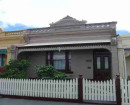E.P. Robinson WoolScourer
13 Bridge Street, NEWTOWN VIC 3220 - Property No 201105
-
Add to tour
You must log in to do that.
-
Share
-
Shortlist place
You must log in to do that.
- Download report
Statement of Significance
B Listed - Regional Significance
The complex of buildings on this industrial site contains structures and works which reflect a great many facets of site activity. There is evidence of the early use of the site for wool scouring with later developments still remaining. There are also aspects of more recent millinery activity still obvious and in use today. Much of what remains however, in terms of structures, is not significant and represents a typical site layout which has evolved over time with the most dominant characteristics reflecting recent decision-making and past 1960s economic planning. The significant cultural property on the site is the important working remains of scourlng and carbonising lines, with the associated overhead belt-drive machinery in the region, a feature
-
-
E.P. Robinson WoolScourer - Physical Description 1
The site complex is made up of a number of buildings reflecting the different trends of activity and phases of development of the scouring and carbonising works. There is evidence of a building dating from c1918 -1920s, that is the Marnock Vale Wool Scouring Works. A shed area, now incorporated into the complex has walls, truss systems and possibly roofing which dates from this period.
There is also remaining, within the complex, buildings which date from the 1930s and 1940s, that is the Collins No.2 Woollen Mill.
In both of the above cases, some structural members remain, with later additions modifying the earlier built forms and changing use and layout patterns.
Within the main building, dating from the 1930s, is some very important industrial plant dating from c1920 remaining. The early wool scouring plant certainly predates existing plant at all other sites in the area and sits alongside more modern items of five to thirty years old.
Of principal interest is an early scouring line, mad up of cast-iron bowls set in linear sequence and a separate carbonising line. made up of a large, narrow wooden trough which is lead-lined. Both lines are originals from earlier site works and are complete with overhead, leather belt-driven machinery still in operation. In this case, scouring and carbonising are handled as separate activities, with their combination depending on the type of wool and required work output.
Of additional interest is the narrow width of the early processing line, almost half the size of the more recent "Phoenix" plant and about a quarter the size of the . new elevated line, installed in the adjacent building in the 1980s.
This plant is the most important remaining in the area. It is currently in use, despite inefficiencies that relate to its age and size. Of importance too, is the manufacturer:-
scouring line & J. Dyson and Co. Geelong
neutralising lines cast-iron troughs
carbonising line made up on site 50 feet long large lengths of Oregon lined with lead to accommodate acid usage.
The overall building complex has undergone considerable modification and modernisation over time. The remains of earlier building works are minimal and altered to accommodate regular updating of the site. Of interest however, is the way it does reflect the numerous changes and site uses.
The remaining early scouring and carbonising plant is by far the most important aspect of the site from a heritage conservation perspective.
Within the region the Sunnyside Woollen Mill and the Barwon Wool Scouring Works in Gravel pits Road has comparable scouring plant but not carbonising plant.
Heritage Study and Grading
Greater Geelong - City of Newtown Urban Conservation Study
Author: Context Pty Ltd
Year: 1991
Grading:
-
-
-
-
-
MIHARO
 Victorian Heritage Register H1137
Victorian Heritage Register H1137 -
BARWON BANK
 Victorian Heritage Register H0425
Victorian Heritage Register H0425 -
CLAREMONT
 Victorian Heritage Register H1127
Victorian Heritage Register H1127
-
-









